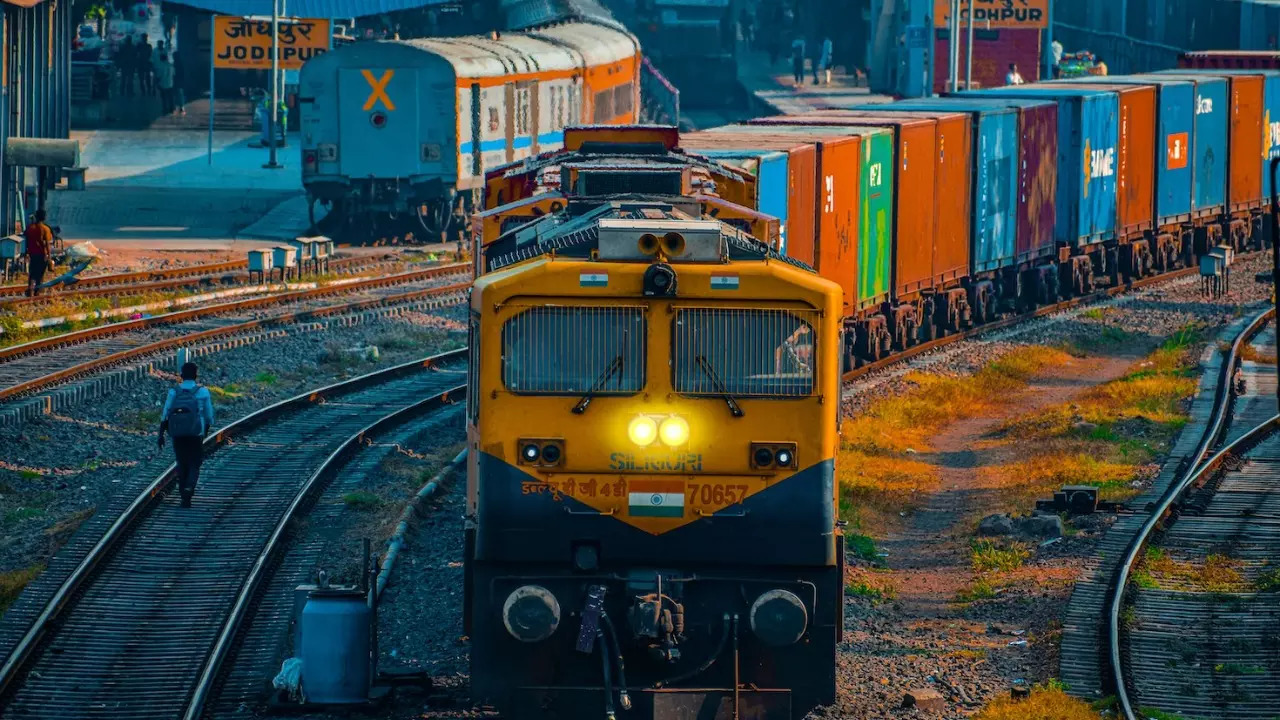Trending:
It Is Time To Reset And Reimagine Indian Railways To Make It Fighting Fit For India @2047
?India today is at an inflexion point. And it is time to reset, reboot and reimagine Indian Railways.

It Is Time To Reset And Reimagine Indian Railways To Make It Fighting Fit For India @2047
The Epoch-Making Moment
The railroad arrived in India, 170 years, 7 months and 22 days ago, on April 16, 1853, within two decades of its invention in England. On that epoch-making day, when the first train in Asia, operated by the Great Indian Peninsula Railway and hauled by three steam locomotives Sindh, Sultan, and Sahib, with 400 guests onboard traversed 34 km distance between Boribunder and Thane in 1 hour 15 minutes, the city of Bombay woke up to a 21-gun salute.
A Living and Learning Organization
It is befitting then, that sooner, Indian railways (IR) got the moniker ‘lifeline of the nation’ . And over the past 170 years, despite taking many detours and traversing steep gradients, it has proved to be a ‘living and learning organization’ in an era, when the Fortune-500 transnational corporations have an ultralow shelf-life of less than 30 years. As per counting by this author, before Covid-19 stuck, IR operated 22,593 trains daily (9141 freight and 13,452 passenger) to transport 203.88 million tonnes freight and 24 million passengers daily. In FY2023, it carried 1500MT freight . Also, between independence and now, IR has increased route length from 55000 km to 69000 km, and from a mixture of gauges (broad, meter and narrow) today largely is a uni-gauge fully electrified network.
More importantly, unlike its parent British Rail that painfully convulsed under the largely unsuccessful restructuring and privatization under British Prime Minister Margret Thatcher in 1990s, IR has chugged along as a government owned entity and remains integral to the very being of ‘India that is Bharat’.
Why Talk of Reform Then
The reasons are legion. More important ones are as described below-
One, on the eve of Independence, in 1950, IR carried 90% of passengers and 80% of freight traffic. In 2023 its market share has dwindled to 10% of the passenger traffic and 25% of freight traffic.
Two, for the past few years IR has been continuously losing high-end passengers to the airlines and low-end passengers to short and long-distance buses. As regards the freight, IR stands relegated as the carrier of few low value commodity products. It has so far not assumed the role of an aggregator of the high value smalls and is losing even its bread-and-butter commodity traffic to highly improved highways and expressways.
Three, IR finances have nosedived, Its operating ratio is perennially, close to 100 (i.e., to earn Rs, 1, IR spends close to Rs. 1) , which leaves it with no internal accrual for the much-needed safety work, renewal of critical assets like the track , the modernization of signalling and communication, provisioning of traffic facility and passenger amenity works.
Four, notwithstanding the credible performance of IR as a carrier of passengers and the freight (despite the losing market share), its track record as creator of new lines has been ordinary. In 76 years since independence, it has barely added 14000 km of new railway lines @182 km per year. Contrarily, coming from the behind, for the last 25 years China has added 4000 km new line annually, China also boasts of World’s largest semi-speed (250 kmph) and high-speed (350kmph) rail network.
A case in point is Eastern and Western Dedicated Freight Corridors being constructed by the DFCCIL. These were to be completed by FY2012 at the combined cost of Rs. 50000 crores but are not yet fully operational. In the interim their completion cost has more than doubled. The sole exceptions of time bound construction of new lines have been The Assam Rail Link project, led by Karnail Singh ( 1948-1950) and 760 km Konkan Railway project, led by E. Sreedharan (1990-1997).
Five, after the independence, 44 disparate railway systems in the country were reorganized by regrouping them into six compact Zones in 1950 ( Northern, Western, Central, Southern, Eastern and Northeastern). Today it has mushroomed to 19 Zones and 70 divisions. It is worth noting that the growth of Zones and Divisions have largely followed the political expediency largely before the arrival of the present government and have not been tailor made to improve administrative and operational performance.
Six, historically IR perforce forayed into many non-core areas and continues to be saddled with them though the rationale to persist with them has long got expired.
Reforms Galore
No entity in India whether the government owned or private corporate, has been subjected to as many committees to reform it than Indian Railways. The effort to reform IR traces back to its very conception in the pre-independence era and it began with the British Indian government nationalizing many railway lines initially constructed by British companies on concession.
To cut the long story short, the major reforms of IR during the British era were in 1905 , the setting up of the Railway Board through The Indian Railway Board Act, 1905 Act No 4 of 1905 based on the Robertson Committee Report(1902) and the reorganization of the Railway Board on 24th March 1924 based on the recommendation of Ackworth Committee (1921) Report. Ackworth Committee also mandated separation of the Railway Finances from General Finances which led to the separate Railway Budget, which was merged with the general budget in 2017.
Committees, Committees and Committees
Post-independence, various committees have been appointed to recommend reforms in Indian Railways. These include but are not limited to Prakash Tandon Committee (1994), Khanna Committee (1998), Rakesh Mohan Committee (2001), Sam Pitroda Committee (2012), High Powered Committee on Railway Safety headed by noted scientist Dr, Anil Kakodkar (2012), One Man E. Sreedharan Committee (2014) and Bibek Debroy committee (2015).
Two things are common with regard to all these committees- first, they were all appointed by the Ministry of Railways (Railway Board) and second, recommendations of most committees were not implemented. The only committees whose recommendations were partially implemented are- Kakodkar Committee, Sreedharan Committee, and Debroy Committee that too under past nine years of NDA government.
Re-Set and Reboot Imperatives
India today is at the inflexion point . And it is time to reset, reboot and reimagine Indian Railways. Below are the three reform imperatives-
One, India has either already dethroned or will soon dethrone, China, as the world’s most populous country. UN projects India's population to be 1.64 billion by 2047, of which nearly 0.82 billion (~50%) shall be residing in urban areas. And the demographic dividend of the country will mean a highly mobile populace.
Two, India will be world’s third largest economy soon and aspires to be a developed nation in 2047. It also wants to dethrone China as the factory of the world.
Three, the biggest imperative is that, if IR has to remain relevant in decades to come, it must shed the tag of bulk commodity carrier and position it as the door-to-door fixed time delivery logistics company.
Talking the Talk
My Reform 2.0 agenda for IR to be fighting fit to meet the challenges of India@2047 are as under. And these were needed yesterday:
One, implement unfinished reforms recommended by Kakodkar Committee (2012), Sreedharan Committee (2014) and Debroy Committee (2015). Railway Board has no business to be in the business of tendering and contracts and independent empowered statutory. Railway Safety Authority (RSA) was needed yesterday.
Two, Enterprise Reform: Change the current paradigm of the Railway Board as the policy framer, operator and regulator in one. Make the policy making, the responsibility of MOR, transform nimble Railway Board into Joint Stock company and 19 disparate zones into 4 operational companies whose value can be harnessed later through the public offering of equity (Japanese railways way). With dedicated freight corridors and HSR going companies way along with the port connectivity projects, it is over to company owned railways era once again.
Three, separate construction and operations The massive need for construction of new railway lines urgently requires a dedicated best practices focused construction organization, an activity that must be fully funded by government.IR must be responsible solely to operate and maintain profitably. Subsidies rightly are government’s responsibility.
Four, hive off non-core-schools, colleges and hospitals: Railways dabbled into these because of the situational compulsions in past. They are better managed by private entities today.
Five, collapse production units into one company: To harness economy of scale, collapse all production units, either as one or maximum three- one for coaches, one for locomotive and one for parts. Infuse world best practices technology.
Six, reform RDSO time for RDSO to focus on the cutting-edge research, best practices technology and state-of-the-art design. Remove inspection (golden goose for officials) from the mandate of RDSO.
Last, but not the least, Indian Railway Management Service (IRMS) the nostrum to end IR ‘silo-culture’ instead of curing the ailment might kill the patient. Railway services were once toast of Indian Civil Services aspirants. Confused IRMS today is second grade service with few takers. Also, it has not ended silo working. Worse IR is unable to decide how to train the first batch IRMS officers.
Even Bibek Debroy Committee recommended eight services to be broadly categorized in two bigger groupings viz. technical and non-technical services. It is time to listen to Debroy. There is no prize in reversing the decision after the collapse of a major railway bridge constructed in 19th century.
Trending:

Akhileshwar Sahay author
Akhileshwar Sahay an ex Indian Railways official and formerly Strategic Advisor Delhi Metro Rail Corporation is a noted Infrastructure Expert and Indi...View More
End of Article
Subscribe to our daily Newsletter!
Related News





Why History Will Judge Joe Biden Kindly As A Pragmatic American Leader

Guru Purnima Special: How to Recognise Your Guru? Sadhguru Explains

Myanmar – The Elephant In The Room For ASEAN And India

Bharatiya Nyaya Sanhita 'Not A Welcome Change', Implemented Without Discussion: Amartya Sen

Travelling With The Indian Cricket Team And Living The Dream; Experience Of A Lifetime







